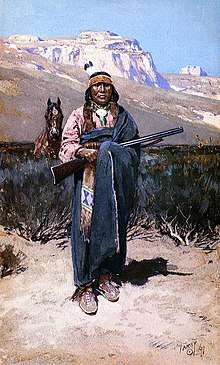Indian brave
During the Indian Wars of the mid to late 19th century, Native American warriors were known as Braves. The awarding of an eagle feather, the traditional insignia of an Indian brave, was an important rite of passage into manhood.

Insignia
To qualify as a warrior, and thus earn the right to wear an eagle feather, Indian youths were required to perform an act of courage on behalf of their tribe. For plains Indians such as the Sioux or Apache this included killing and scalping an enemy, capturing a horse, disarming an opponent, infiltrating the enemy's camp, taking a prisoner, or striking the same opponent three times in battle. Few braves received more than three eagle feathers during their lifetime due to the bird's rarity and sacred status, but exceptionally courageous and talented warriors such as Sitting Bull, Geronimo or Cochise could ultimately earn enough feathers to make a war bonnet.[1]
Plains Indians frequently decorated their buckskin war shirts with the scalps of their enemies, bone breastplates as protection from cold weapons, bear claws, porcupine quills or wolf teeth to demonstrate their hunting prowess, silver conchos made from Morgan Dollars or Mexican pesos, and elaborate glass beadwork. This attire served the dual purpose of terrifying their enemies, and ensuring the warrior looked his best before the Great Spirit if he was killed in battle. Common bead patterns, believed to protect the wearer in battle, included the thunderbird, diamonds and crosses, or zigzags in white, cyan, black, red, orange and yellow.[2][3]
Among tribes such as the Pawnee, Iroquois and Mohawk, warriors received a Mohican as part of their initiation into manhood. In these cultures, a brave was not allowed to shave his head until he had seen battle. Tattooing and scarification were also in use among Southwestern tribes such as the Cherokee, Seminole and Cree[4] to enable a warrior to demonstrate his resistance to pain, signify allegiance to a specific tribe or marital status, and to draw favours from totem spirit animals such as Raven, the Great Bear, or the serpent.[5] Centuries before the arrival of the first pioneers, the Indian shaman would tattoo braves using cactus spines dipped in a carbon-based ink.[6][7]
Horsemanship
Indians learned to ride from a young age, on small cayuse horses originally introduced by the Spanish conquistadors.[8] These were usually ridden bareback, with only a blanket for comfort. At long range, a brave would cling to the side of his horse and use it as a shield, while returning fire with his own gun or bow and arrow.[9]
Cold weapons
At close range, Indian braves favoured edged weapons such as knives. Tomahawks were originally carved from stone, but by the 18th century forged iron axes could be acquired through trade. Some had decorative star or heart-shaped cutouts, and the tomahawks of Indian chiefs sometimes featured a pipe bowl.[10] Spears could be thrown, or used as lances. Other commonly used weapons included ball-topped clubs and gunstock war clubs[11] decorated with brass thumbtacks taken from old trunks burned as firewood by American pioneers.[12] Heroic deeds were recorded by carving notches into the club, or less commonly, by attaching an eagle feather.[13]
Ranged weapons
Before the arrival of the white man, Indians used bows and slingshots in small-scale skirmishes with rival tribes.[14] By the 18th century, however, firearms were in widespread use. The braves of the Indian Wars made use of many different types of gun, including flintlock horse pistols, long rifles, Colt revolvers, Springfield muskets, Remington rolling blocks, Sharps carbines taken from the US cavalry, and repeating rifles such as the Winchester yellowboy or Spencer carbine. Cartridge firearms enabled chiefs such as Red Cloud and his dog soldiers to wage a successful guerrilla campaign against the blue-coats, until attrition and countless atrocities committed by the whites against Indian women and children forced the braves to surrender.[15]
In popular culture
Although Indian braves were frequently demonised and dehumanised in contemporary accounts, they have also been portrayed sympathetically in Dime novels. Chingachgook from Cooper's Last of the Mohicans, May's Winnetou, and Ellis' Deerfoot of the Shawnee are represented as selfless, heroic protagonists as intelligent and competent as any white man.[16]
During the Cold War, Russian and East German Red Westerns such as the Sons of the Great Bear subverted contemporary American portrayals of the Indian Wars by romanticising the Indian brave's resistance to genocide at the hands of the white man. In the present day, so-called Red Indians are held in high esteem in Russia and Germany, with the colour red being associated not with their skin tone, but with their courage and skill in battle.
Sources
- Bury My Heart at Wounded Knee (1970) by Dee Brown
- Time-Life: The Old West (1971-80), by various authors
References
- McDermott, John Dishon (January 11, 1998). "A Guide to the Indian Wars of the West". U of Nebraska Press – via Google Books.
- "Native American Beadwork: Wampum belts, beaded jewelry, and other Indian beading arts". www.native-languages.org.
- "Native American Beadwork: a Rich History of Cultural Techniques". www.powwows.com. July 27, 2019.
- Inked
- Early American tattooing
- Indian tatttooing artefacts
- Drawing with great needles
- Horseman, Eclectic. "A Primer on Old Indian Tricks & Natural Horsemanship".
- Time Life Old West: The Indians (1976)
- "History of Tomahawks". Tomahawk Throwing Resources - The Axe Throwers Guide.
- "Gunstock club - A Place in History - Object 1886.1.818 Pitt Rivers Museum". web.archive.org. October 7, 2010.
- Taylor, Colin F. (July 2, 2005). "Native American Weapons". University of Oklahoma Press – via Google Books.
- Plenty Coups, Chief of the Crow
- Spence, Lewis (August 9, 2012). "The Myths of the North American Indians". Courier Corporation – via Google Books.
- "Weapons of the Indian Wars - Stone Age into the Industrial Age". True West Magazine. January 13, 2015.
- Campfire and Wigwam, by Edward S Ellis